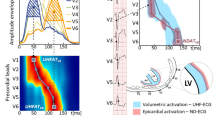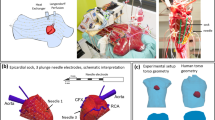Abstract
The ECG interval from the peak to the end of the T wave (T peak-T end) has been used as an index of transmural dispersion of ventricular repolarization (DVR). The correlation between the T peak-T end interval and the global DVR, however, has not been well-evaluated. Methods: Monophasic action potentials (MAPs) were recorded from 51 ± 10 epicardial and 64 ± 9 endocardial sites in the left ventricles of 10 pigs, and from 41 ± 4 epicardial and 53 ± 2 endocardial sites in the right ventricles of 2 of the 10 pigs using the CARTO mapping system. The end of repolarization times over the epi- and endocardium were measured, and the end of repolarization dispersions over the epicardium (DVR-epi), over the endocardium (DVR-endo) and over both (DVR-total) were calculated. The QTpeak, QTend and T peak-T end intervals as well as the QTpeak and QTend dispersions were obtained from the simultaneously recorded 12-lead ECG.
Results: The maximal T peak-T end intervals (57 ± 7 ms) were consistent with the DVR-total (58 ± 11 ms, p > 0.05), and significantly correlated with the DVR-total (r = 0.64, p < 0.05). However, the mean T peak-T end intervals (44 ± 5 ms), and T peak-T end intervals from lead II (41 ± 6 ms) and V 5 (43 ± 5 ms) were all significantly smaller than and poorly correlated with the DVR-total, as were the QTpeak and QTend dispersions (15 ± 2 ms vs. 21 ± 4 ms).
Conclusion: The maximal T peak-T end interval may be used as a noninvasive estimate for the global DVR, but not the QTpeak and QTend dispersions, nor the mean T peak-T end interval and that from a single lead.
Similar content being viewed by others
References
Kuo CS, Munakata K, Reddy CP, Surawicz B. Characteristics and possible mechanism of ventricular arrhythmia dependent on the dispersion of action potential durations. Circulation 1983;67:1356–1367.
Pastore JM, Girouard SD, Laurita KR, Rosenbaum DS. Modulated dispersion explains changes in arrhythmias vulnerability during premature stimulation of the heart. Circulation 1998;98:2774–2780.
Sylven JC, Horacek BM, Spencer CA, Klassen GA, Montague TJ. QT interval variability on the body surface. J Electrocardiol 1984;17:179–188.
Day CP, McComb JM, Campbell RW. QT dispersion: An indication of arrhythmia risk in patients with long QT intervals. Br Heart J 1990;63:342–344.
Barr CS, Naas A, Freeman M, Lang CC, Struthers AD. QT dispersion and sudden unexpected death in chronic heart failure. Lancet 1994;343:327–329.
Macfarlane PW, McLaughlin SC, Rodger C. Influence of lead selection and population on automated measurement of QT dispersion. Circulation 1998;98:2160–2167.
Lee KW, Kligfield P, Okin PM, Dower GE. Determinants of precordial QT dispersion in normal subjects. J Electrocardiol 1998;(31 Suppl):128–133.
Kors JA, van Herpen G, van Bemmel JH. QT dispersion as an attribute of T-loop morphology. Circulation 1999;99:1458–1463.
Antzelevitch C, Sicouri S, Litovsky SH, Lukas A, Krishnan SC, Di Diego JM, Gintant GA, Liu DW. Heterogeneity withinthe ventricular wall: Electrophysiology and pharmacology of epicardial, endocardial and M cells. Cir Res 1991;69:1427–1449.
Yan GX, Antzelevitch C. Cellular basis for the normal T wave and the electrocardiographic manifestations of thelong QT syndrome. Circulation 1998;98:1928–1936.
Lubinski A, Kornacewicz-Jach Z, Wnuk-Wojnar AM, Adamus J, Kempa M, Krolak T, Lewicka-Nowak E, Radomski M, Swiatecka G. The terminal portion of T wave: A new electrocardiographic marker of risk of ventricular arrhythmias. Pacing Clin Electrophysiol 2000;23:1957–1959.
Taggart P, Sutton PM, Opthof T, Coronel R, Trimlett R, Pugsley W, Kallis P. Transmural repolarisation in the leftventricle in humans during normoxia and ischaemia. Cardiovasc Res 2001;50(3):454–462.
Smetana P, Pueyo E, Hnatkova K, Batchvarov V, Camm AJ, Malik M. Effect of amiodarone on the descending limb of the T wave. Am J Cardiol 2003;92:742–746.
Yuan S, Blomstrom-Lundqvist C, Olsson SB. Monophasic action potentials: Concepts to practical applications. JCardiovasc Electrophysiol 1994;5:287–308.
Franz MR. Current status of monophasic action potential recording: Theories, measurements and interpretations. Cardiovasc Res. 1999;41:25–40.
Yuan S, Kongstad O, Hertervig E, Holm M, Grins E, Olsson B. Global repolarization sequence of the ventricular endocardium: Monophasic action potential mapping in swine and humans. Pacing Clin Electrophysiol 2001;24:1479–1488.
Kongstad O, Yuan S, Hertervig E, Holm M, Grins E, Olsson B. Global and local dispersion of ventricular repolarization: Endocardial monophasic action potential mapping in swine and humans by using an electro-anatomical mapping system. J Electrocardiol 2002;35:159–167.
Xia Y, Kongstad O, Hertervig E, Li Z, Holm M, Olsson B, Yuan S. Activation recovery time measurements in evaluation of global sequence and dispersion of ventricular repolarization. J Electrocardiol 2005;38(1):28–35.
Gepstein L, Hayam G, Ben-Haim SA. A novel method for nonfluoroscopic catheter-based electroanatomical mapping of the heart. In vitro and in vivo accuracy results. Circulation 1997;95:1611–1622.
Liu S, Yuan S, Hertervig E, Kongstad O, Holm M, Grins E, Olsson SB. Monophasic action potential mapping in swine and humans using modified-tip ablation catheter and electroanatomic mapping system. Scand Cardiovasc J 2002;36(3):161–166.
Harumi K, Burgess MJ, Abildskov JA. A theoretic model of the T wave. Circulation 1966;34:657–668.
Franz MR, Bargheer K, Costard-Jackle A, Miller DC, Lichtlen PR. Human ventricular repolarization and T wave genesis. Prog Cardiovasc Dis 1991;33:369–384.
Zabel M, Portnoy S, Franz MR. Electrocardiographic indexes of dispersion of ventricular repolarization: An isolated heart validation study. J Am Coll Cardiol 1995;25:746–752.
Lubinski A, Lewicka-Nowak E, Kempa M, Baczynska AM, Romanowska I, Swiatecka G. New insight into repolarization abnormalities in patients with congenital long QT syndrome: The increased transmural dispersion of repolarization. PACE 1998;21:172–175.
Medina-Ravell VA, Lankipalli RS, Yan GX, Antzelevitch C, Medina-Malpica NA, Medina-Malpica OA, Droogan C, Kowey PR. Effect of epicardial or biventricular pacing to prolong QT interval and increase transmural dispersion of repolarization: Does resynchronization therapy pose a risk for patients predisposed to long QT or torsade de pointes? Circulation 2003;107:740–746.
Davey PP. QT interval measurement: Q to TApex or Q to TEnd? Journal of Internal Medicine 1999;246:145–149.
Nakagawa M, Takahashi N, Watanabe M, Ichinose M, Nobe S, Yonemochi H, Ito M, Saikawa T. Gender differences in ventricular repolarization: Terminal T wave interval was shorter in women than in men. Pacing Clin Electrophysiol 2003;26:59–64.
Zabel M, Lichtlen PR, Haverich A, Franz MR. Comparison of ECG variables of dispersion of ventricular repolarization with direct myocardial repolarization measurements in the human heart. J Cardiovasc Electrophysiol 1998;9:1279–1284.
Knollmann BC, Tranquillo J, Sirenko SG, Henriquez C, Franz MR. Microelectrode study of the genesis of the monophasicaction potential by contact electrode technique. J Cardiovasc Electrophysiol 2002;13:1246–1252.
Stankovicova T, Szilard M, De Scheerder I, Sipido KR. M cells and transmural heterogeneity of action potential configuration in myocytes from the left ventricular wall of the pig heart. Cardiovasc Res 2000;45(4):952–960.
Yan GX, Shimizu W, Antzelevitch C. The characteristics and distribution of M cells in arterially-perfused canineleft ventricular wedge preparations. Circulation 1998;98:1921–1927.
Hamlin RL, Burton RR, Leverett SD, Burns JW. Ventricular activation process in minipigs. J Electrocardiol. 1975;8(2):113–116.
Author information
Authors and Affiliations
Corresponding author
Rights and permissions
About this article
Cite this article
Xia, Y., Liang, Y., Kongstad, O. et al. T peak-T end Interval as an Index of Global Dispersion of Ventricular Repolarization: Evaluations Using Monophasic Action Potential Mapping of the Epi- and Endocardium in Swine. J Interv Card Electrophysiol 14, 79–87 (2005). https://doi.org/10.1007/s10840-005-4592-4
Received:
Accepted:
Issue Date:
DOI: https://doi.org/10.1007/s10840-005-4592-4




